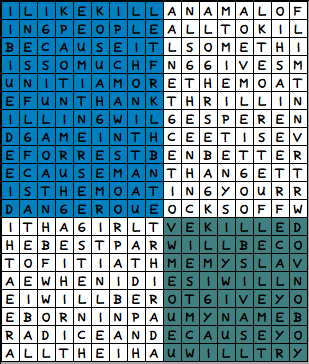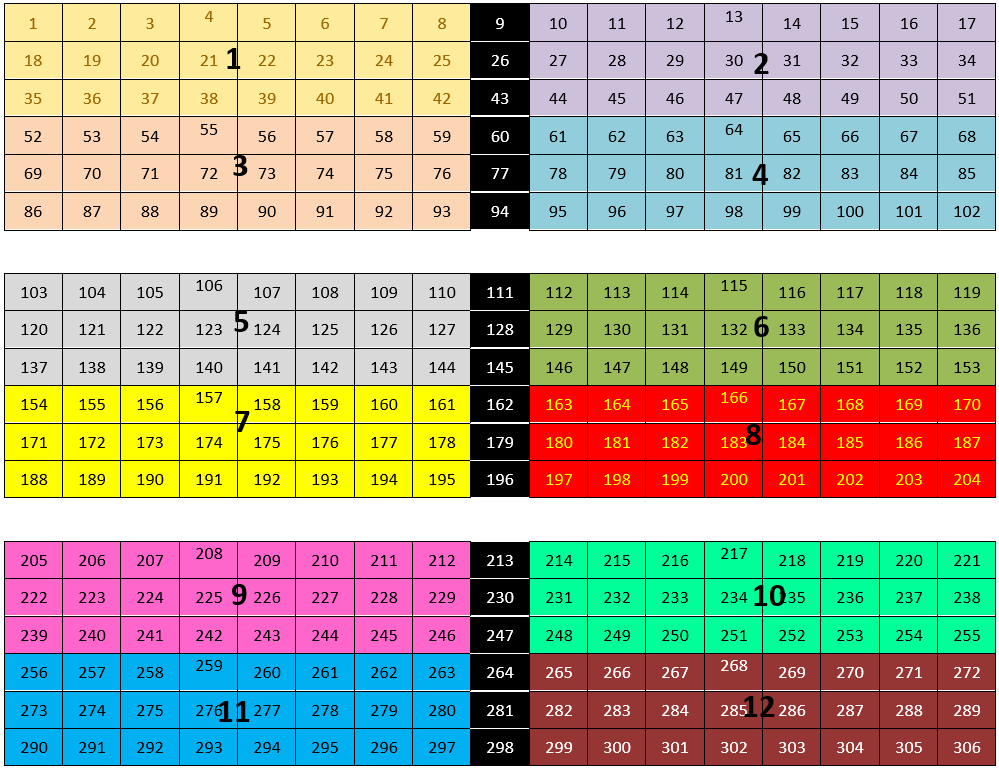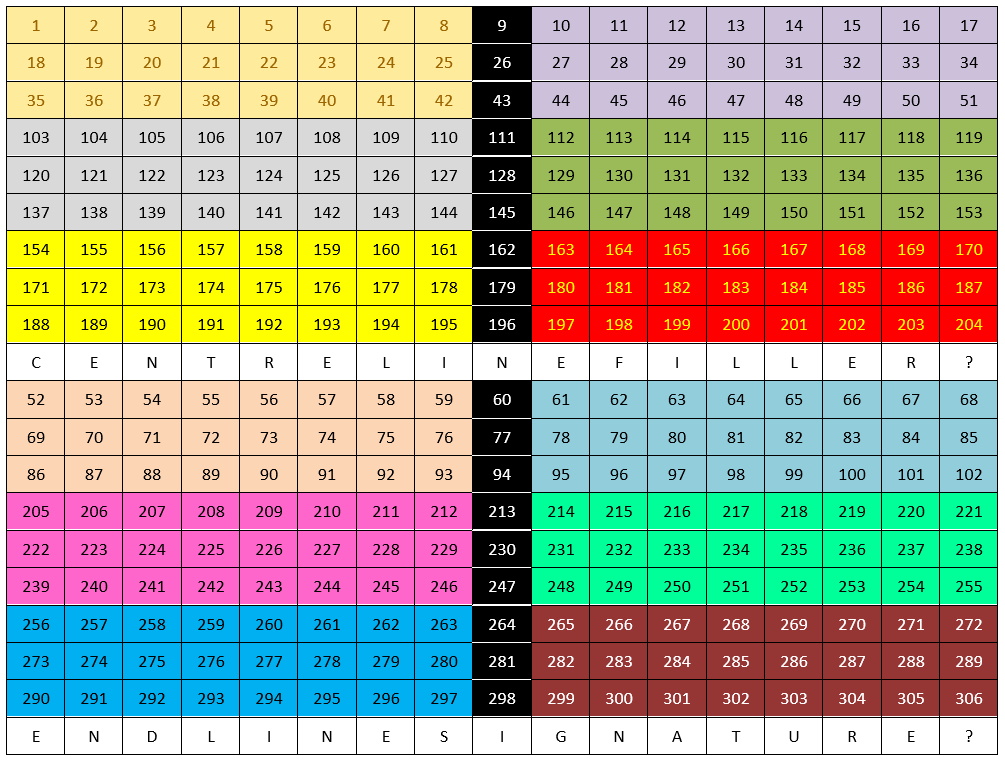Thanks, good idea! Same format like in "Zodiac 340 route transposition batch"-file found in AZDecrypt/Ciphers/Batch? Or single files?
If possible, thanks.
Hi,
i did a similar test some time ago and i’m pretty sure i documented it here in the forum. However, I cannot find this thread. My sourcecode management shows that I implemented the test on February 16. Well…maybe I wanted to document it and then I forgot it. Absent-mindedness is one of my strengths =)
Best I could find was a reference here: http://www.zodiackillersite.com/viewtop … 741#p50741
In this test I have cut the cipher into stripes and applied different transformations to each stripe before seaming them together again. (129056 permutations in total). Unfortunately „(B) Simple Vertical“ from your resource is not considered in my test. Maybe I will give it a try. I also created a similiar test for all permutations of quadrant sizes. In this post you will find a download link to the generated ciphers.
Also here: http://www.zodiackillersite.com/viewtop … 781#p63781
I noticed this a long time ago and ran some tests in which I performed all combinations of Rotation/Flip/Mirror for all possible quadrant sizes (really very, very many ciphers were created). Unfortunately without result.
Best I could find was a reference here: http://www.zodiackillersite.com/viewtop … 741#p50741
Also here: http://www.zodiackillersite.com/viewtop … 781#p63781
Thanks!
The batch file is ready. It contains all combinations of None/Reverse/Mirror/Flip/Rotate cw/Rotate ccw, each for all combinations of quadrant sizes (minimum 7×7):
https://www.dropbox.com/s/ytzy0ztxtf1f7e5/quadrants.txt
I have run the file through the batch-substitution solver of AZDecrypt. Unfortunately without result so far. But I only used the default settings.
My test assumes that the plaintext of z340 is in four different quadrants. So each quadrant must first be correctly untransposed. Then the contents of the quadrants are merged. The reading direction of the correctly untransposed cipher is therefore not left / right / top / bottom. Here is an example:
Top left: Reverse (9×12)
Top right: Mirror (8×12)
Bottom left: Flip (9×8)
Bottom right: Rotate Clockwise (8×8)
Plaintext is the first 340 characters of z408. After the correct untranspose it looks like this:
Now, the four quadrants have to be read out one by one, then you have the plain text. The ciphers in the batch file already contain this step.
I have run the file through the batch-substitution solver of AZDecrypt. Unfortunately without result so far. But I only used the default settings.
Thanks for the file and explanation Largo, I ran them through more thoroughly, best result:
Score: 20305.36 IOC: 0.0761 Multiplicity: 0.1852 Minutes: 30.46 Repeats: ENALIN INGA DIED TONI ERAN REET ENTI ING ALO AND PT-to-CT cycles: 263 Quadrants(3, 3, 1, 2) RFSATOSPAUSESINGR EWERANEACHDRSMEPR OIFALOGWASSITUALO FGOOBUTSINVETHREE TSOCAFOOLAKEPETIN GORSREELENTIATTAS SOCUSETSDANINTENA LINSGARNEYSAIMEAR ASSROUARESETHEINH ERANDOINGANDTHENA LINECONBEINGINGAS SHISSINANDSTHESEN DUSTREETIHAVETONI CFEMASETBEESCANNO AREATSARMAKERRIDE OTONITYSDIEDMALCE NTIMESSAEANDEESPM UTALKSANDIEDFORTH ETIOISNOHERDEBRAN SPATROUTSCRELLRUS
I have run the file through the batch-substitution solver of AZDecrypt. Unfortunately without result so far. But I only used the default settings.
Thanks for the file and explanation Largo, I ran them through more thoroughly, best result:
Score: 20305.36 IOC: 0.0761 Multiplicity: 0.1852 Minutes: 30.46 Repeats: ENALIN INGA DIED TONI ERAN REET ENTI ING ALO AND PT-to-CT cycles: 263 Quadrants(3, 3, 1, 2) RFSATOSPAUSESINGR EWERANEACHDRSMEPR OIFALOGWASSITUALO FGOOBUTSINVETHREE TSOCAFOOLAKEPETIN GORSREELENTIATTAS SOCUSETSDANINTENA LINSGARNEYSAIMEAR ASSROUARESETHEINH ERANDOINGANDTHENA LINECONBEINGINGAS SHISSINANDSTHESEN DUSTREETIHAVETONI CFEMASETBEESCANNO AREATSARMAKERRIDE OTONITYSDIEDMALCE NTIMESSAEANDEESPM UTALKSANDIEDFORTH ETIOISNOHERDEBRAN SPATROUTSCRELLRUS
RFSATOS PAUSES IN GREWER AN EACH DRS ME PROIFALOG WAS SITUAL OF GOO BUTS IN VE THREET SO CAFOO LAKE PETING ORS REELENTIATT AS SO CUSETS DAN INTENAL INS GARNEY SAIME A RASS ROU ARE SE THE IN HER AND OING AND THEN A LINE CON BEINGING AS SHISS IN ANDS THE SENDUSTREET I HAVE TO NIC FEM A SET BEES CAN NO AREATS ARMAKER RIDE O TO NITYS DIED MAL CENTIMES SAE AND EESPMU TALKS AN DIED FOR THE TIO IS NO HER DE BRANS PATROUT SCRELL RUS
Hi All!
I’m new here so please be nice ![]() .
.
I just wanted to see if this had been proposed before (had a search on some of the threads and didn’t spot it – apologies if it has):
Like many of you feel, to me the cipher screams "quadrants". Almost as if Z wanted to create a "Zodiac" transposition related to his symbol.
However some of the clues that have been found (first 3 lines of top & bottom half no repeats, top half far more bigrams than bottom half etc) just don’t seem to be completely solved by the quadrant hypothesis alone.
Anyway I had a thought: Z sent the 408 in 3 "segments" of 17×8. I’ve always had a suspicion like many of you that rows 10 and 20 of the 340 were filler (Zodaik signature at the end and a centre line splitting the cipher in the middle). That leaves a 17×18 cipher of "real" text. So say his initial plan was to split it into 3 17×6 ciphers like the 408. Only the 408 was solved so quick he got "annoyed" and decided to change it up.
Either he gives up and puts it all back together and messes around from there. Or he uses his zodiac "quadrant" methodology on each segment. We end up with 12 segments of 8×3 lines that he places at various points in the larger (now) 340 cipher (and simultaneously does transpositions on some of them?). Maybe he leaves the centre-line (column 9) basically untouched as it doesn’t easily split into any of the sections?
This could explain a) the 3 line symmetry between the top and bottom half b) the variety in bigrams between different sections of the cipher (none in the bottom-left corner) c) the inconsistency in some of the clues d) some of the p19 ngrams. e) the south east pivot (doesn’t explain the other pivot as that crosses row 10 which I’m supposing is filler). f) the odd distribution of some symbols
Sorry if none of this is helpful or if I should’ve posted it elsewhere, but just thought some of you experienced cryptographers might be able to formulate an easy way to quiz this as a possibility?
Welcome to the forum Xmassloth!
Your hypothesis does feel a bit arbitrary and has multiple tangents that do not seem to fit together.
12 segments of 8 by 3 = 288 characters. How do you get to 288 characters? Why 8 by 3?
And how could that explain any of this:
This could explain
a) the 3 line symmetry between the top and bottom half
b) the variety in bigrams between different sections of the cipher (none in the bottom-left corner)
c) the inconsistency in some of the clues
d) some of the p19 ngrams.
e) the south east pivot (doesn’t explain the other pivot as that crosses row 10 which I’m supposing is filler).
f) the odd distribution of some symbols
Sorry to question your first post like this.
![]()
One of the problems with transposition in the Z340 is that there are 340! possible unique variations. 340! is a number with 715 digits, not even a universe sized computer would be able to search all, let alone even a meaningful fraction of it. We need something "good" to go on, it has to make sense in some way. At least for me.
340! = 5100864472103711080930193283927 29336303446719828853760394685824379811 30708498852292131363729546498990203510 11761059778806133788936493577434500361 68341518898247240134633888486114142274 07131388805908338112936942713654312102 01323723370857438895402320411929506183 96959886338295281838936923583250091164 12814178085996438696887269886990263126 00541139182490611593239476045067552375 31573871239151799752050162388221642647 38634685875388180608752182405041052057 06947492365188106425431862641010474387 42041855416428964941040862985429878778 62041808504453671655093398052608362378 86088058511128061771315622325534263276 92906101835274773532720140124160000000 00000000000000000000000000000000000000 00000000000000000000000000000000000000
No problem questioning it! One of the reasons I posted is because you can spend so long looking at it you convince yourself you’ve spotted patterns so it’s useful to have someone burst that conviction!
It’s quite possible it’s arbitrary and there’s not a good way to test it as such but let me try answer some of the questions you’ve put:
12 segments of 8 by 3 = 288 characters. How do you get to 288 characters? Why 8 by 3?
12 8×3 segments plus the centre column of 18 characters which, much like the quadrant analysis, we’re unsure what he’s done with (so for arguments sake I’ve suggested he’s left it as is). That gives us 306 characters which is the 340 minus rows 10 & 20 (34 characters).
Why 8 by 3? I’m simply suggesting instead of cutting into quadrants the whole 340 (or 306) cipher he cut each 17 X 6 segment into quadrants. If you leave the centre-column that gives us 12 8×3 sections.
And how could that explain any of this:
a) if the cipher is split into 8*3 sections which he can place where he likes/transpose how he likes it allows for the possibility that rows 1-3 & 11-13 actually started life much closer in the untransposed cipher and underwent similar transpositions which left these rows with no repeats.
b) if different sections undergo different transpositions it could mean transpositions which hide bigrams are isolated to certain sections of the full cipher (which is what is seen)
c) some of the clues point in different directions because there are multiple different transpositions going on across the cipher
d) P19 bigrams can be produced by some simple transpositions across some of the sections without removing the patterns seen elsewhere
e) if section "4" as I call it (rows 11-13, columns 10-17) has undergone a columnar transposition and the section immediately below hasn’t, that could cause a trigram to appear in a column which greatly increases the probability of intersecting another trigram in the untransposed section below to create a "pivot"
f) if some of the transpositions include "mirroring" this could cause some symbols to only appear/disappear in certain sections of the cipher.
Sorry, I don’t know if I’ve explained that too well – it’s much easier to do it graphically so I’m going to work on a few diagrams to try to clarify my meaning. Overall creating 12 sections which can each undergo their own transpositions produces a huge number of possibilities, which is probably why it allows for answers to some of the clues to be shoe-horned in. That’s why my question is not "let’s solve it like this!" my question is: is there any way to interrogate the cipher such as to see the probability Z may have created it like this?
not even a universe sized computer would be able to search all, let alone even a meaningful fraction of it.
Not that anyone of us have access to one but would a quantum computer be able to tackle it? They sound quite amazing.
Google announced it has a quantum computer that is 100 million times faster than any classical computer in its lab. Every day, we produce 2.5 exabytes of data. That number is equivalent to the content on 5 million laptops.
Quantum computers can solve problems that are impossible or would take a traditional computer an impractical amount of time (a billion years) to solve.
Sorry, I don’t know if I’ve explained that too well – it’s much easier to do it graphically so I’m going to work on a few diagrams to try to clarify my meaning. Overall creating 12 sections which can each undergo their own transpositions produces a huge number of possibilities, which is probably why it allows for answers to some of the clues to be shoe-horned in.
Basically quadrants to the power of 2 where the many individually transposed sub parts mold the observations in place.
![]()
That’s why my question is not "let’s solve it like this!" my question is: is there any way to interrogate the cipher such as to see the probability Z may have created it like this?
That could be possible. Do you think he transposed the parts at the plain text or cipher text level? From your detailed explanation of point a) I take it you consider the transposition to have happened at the cipher text level.
Jarlve said;
"Do you think he transposed the parts at the plain text or cipher text level?"
If the ‘pivots’ are taken as intentional, that could be taken as an indicator that
Zodiac went back & forth between the work-in-progress plaintext, into the work-
in-progress ciphertext symbols and the resulting transposed cipher state, to get
the resultant transposed cipher final state that he desired. Presumably the cipher
final state, besides the ciphertext (encoding a plaintext message), also on the
face of it additionally includes a method to indicate how to untranspose the
transposed ciphertext.
If this is the case, then Z340 features such as the two ‘pivots’, the three ‘box
corners’ and other lesser talked about features such as the two ‘fold‘s;
http://zodiackillerciphers.com/images/z … agrams.jpg
may serve a function as part of some kind of ‘detranspositional instruction set’.
Not a happy thought, but it’s one that I’ve embraced – although that means my last
year and a half of Z340 possible anagramming thought results can be consigned to
the trashcan. Also, if you consider the Z340 to have multiple steps of transposition,
that would mean that ‘Period 19’ is not an indicator of any underlaying enciphered
plaintext, but rather just a statistical anomaly arising from the ‘now seen as
apparent disordered’ ciphertext final (transposed) state. Mmm, maybe Dave should
go easy on the ‘Period 19’ lecture angle for a while… . ![]()
Cheers
Do you think he transposed the parts at the plain text or cipher text level?
This "theory" I’ve proposed (more thought experiment really!) would point more towards transposition at the cipher text level. It seems plausible at least that he generated a cipher in a very similar fashion to the 408 first and then transposed the result after (perhaps because of the ease with which the 408 was solved). Not so much an after-thought as an add-on level of complexity to ensure the solve would take a while.
P.S – still working on diagrams, will share when I have something useful
Do you think he transposed the parts at the plain text or cipher text level?
This "theory" I’ve proposed (more thought experiment really!) would point more towards transposition at the cipher text level. It seems plausible at least that he generated a cipher in a very similar fashion to the 408 first and then transposed the result after (perhaps because of the ease with which the 408 was solved). Not so much an after-thought as an add-on level of complexity to ensure the solve would take a while.
P.S – still working on diagrams, will share when I have something useful
One of the big problems with transposition after homophonic encipherment is that it disturbs certain stats. One such stat is simply summing the unigram repeats per row (or per any unit size if you will). Looking at the Z340 there are only 18 unigrams repeats in this way. It is very few and one of the strong observations in the Z340, in 1,000,000 shuffles the lowest I got was 22, so it is not a random occurrence.
So why does the Z340 have only 18 unigram repeats? It is a stat that strongly correlates with use of sequential homophones so there’s that. But it is also possible that Zodiac just tried to not repeat characters per row or per certain unit size.
There are transpositions that do not disturb the stat (locally) such as columnar rearrangement. Say that you rearrange the columns in a 17 by 20 grid. Then the unigram repeats per unit size 17 will not be disturbed, but all other unit sizes will be, and you get a local spike at 17. Example given below, the higher the unit size the more repeats that will occur naturally so take that into consideration.
Original 340, unit size, unigram repeats:
12: 11 13: 14 14: 17 15: 16 16: 17 17: 18 <--- perhaps a local minimum going from 17 to 18 (worth looking into?) 18: 24 19: 24 20: 25 21: 29 22: 30
340 with columns randomly rearranged in 17 by 20, unit size, unigram repeats:
12: 17 13: 20 14: 26 15: 29 16: 26 17: 18 <--- strong local minimum 18: 28 19: 33 20: 35 21: 42 22: 41
At the very least this test is a strong indication against columnar rearrangement after homophonic encipherment in a 17 by 20 grid!
Hmm. That certainly indicates as you say that homophonic encipherment was essentially the last thing he did to the cipher, retaining the spread of symbols along rows. This seems like an important point. From an intuitive point of view that sort of puts pay to the idea he split it in 3 initially – I had always felt the splitting in 3 was something he did after encipherment. In the 408 this is indicated because some words run over between sections. This would seem a strange thing to do if he was splitting it in 3 from the get go with the plain text, but I suppose you never know and it technically doesn’t rule it out. Here are a few crude images to give an example of what I’m saying he might have done (minus the subsection transpositions):
Sections split in 4:
Put back into final 340:
I’ve had a look at some more of the interesting bigram peaks and wondered how this could fit into some of the column/row offsets which seem to be present. Nothing has stuck out at me yet but I keep pondering.





